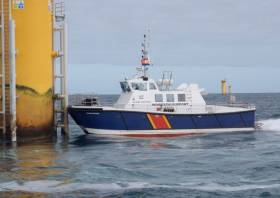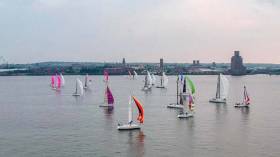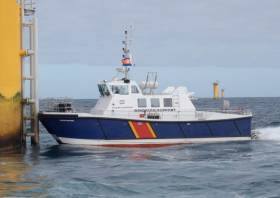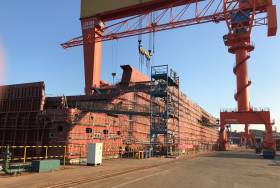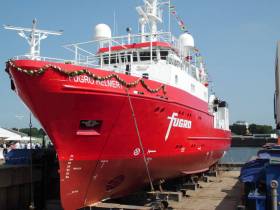Displaying items by tag: irish sea
Departing Dublin Port last night was a small cruiseship when compared to the giants of the industry yet this caller is one of the most prolific visitors and on the Irish Sea this season, writes Jehan Ashmore.
The diminutive Corinthian of just 4,077 gross tonnage and a capacity of 110 guests had arrived from Douglas, Isle of Man from where the Maltese flagged vessel last month was among a quartet that formed a 'Week of Maidens' calls throughout Manx waters.
Prior to the Isle of Man, Corinthian called to Belfast Harbour as a regular and likewise in Dublin the Valletta registered ship has berthed on several occasions this season in the 'Docklands' quarter. This waterfront area once dominated by warehouses and cranes is now occupied by finance houses and appartments lining the Liffey quays between the city-centre and the Tom Clarke (East-Link) bridge.
With an overall draft of just 4m and 88m in length Corinthian easily made a transit of the bascule bridge and took a specific berth upriver along Sir John Rogersons Quay. Along this stretch is a legacy of the Dublin Docklands Development Authority which designated a south quay berth to encourage shipping activity to the quarter.
Instead of routine tea-time departures as typical of the majority of callers, Corinthian had spent a lenghtly stay. The Italian built ship launched for Renaissance Cruises and operated by subsequent owners until acquired by GCL in 2014 departed Dublin Port last night at 23.00hrs and made an overnight passage to Fishguard, Wales.
The port in Pembrokeshire operated by Stena Line Ports this year is scheduled for 33 callers, the majority of those will be carried out by Corinthian totalling 11 visits this season. Among these cruiseships so far to visit this scenic setting on the Pembrokeshire Coast National Park was Variety Voyager a vessel more akin to a private superyacht.
Corinthian is scheduled to return to Dublin next week on Tuesday, July 2nd.
A series of ecological surveys will take place in the Irish Sea off the Dublin and Wicklow coast between now and May next year to provide data on seabirds and marine mammal species to inform the development of the Dublin Array Wind Farm.
The survey dates are weather dependent but will comprise a survey in each calendar month until May 2020, commencing tomorrow (Monday 24 June), with additional monthly surveys this August and September.
The location of the surveys will be off the Dublin and Wicklow coast in the vicinity of the Kish and Bray Banks. Surveys will be undertaken in daylight hours and each will usually be completed over a period of two days.
For the initial survey, the work vessel will not be towing survey equipment. During subsequent surveys the vessels may be towing a hydrophone up to 100m astern and will be restricted in their ability to manoeuvre. Vessels are requested to leave a wide berth.
Details of co-ordinates of the survey areas, and relevant work vessels, are included in Marine Notice No 18 of 2019, a PDF of which is available to read or download HERE.
In an obituary The Scotsman writes about the late Hamish Ross, ferry industry managing director, Born: 17, July 1943 in Lhanbryde, Morayshire. Died: 4 April, 2019, in Douglas, Isle of Man, aged 75.
Hamish Ross, who died in early April in the Hospice Isle of Man, was a prominent figure in the world of Irish Sea shipping over four decades, enjoying leadership roles with Sealink, one of the UK’s major ferry companies of the 1970s and 80s, Sea Containers (who introduced SeaCat fast ferries to the Irish Sea in the 1990s) and latterly with the Isle of Man Steam Packet Company.
However, two of his finest achievements were delivered after his formal retirement in 2007 – as publisher and editor of the famous Sea Breezes shipping magazine, he steered the publication safely through to its centennial in 2019, and he also he spearheaded a successful campaign to erect a permanent memorial in tribute to the heroic sacrifice made by the Isle of Man Steam Packet Company ships and crews during the evacuation of Dunkirk in 1940.
Starting his secondary schooling at Keith Grammar School, Hamish then won a scholarship to Gordonstoun in 1958 through the shipping company Alfred Holt & Co. (Blue Funnel Line). Thus began a 60-year association with the sea.
The first chapter in Hamish’s career, serving on Blue Funnel’s renowned vessels between 1960-71, encompassed the last great era of British merchant shipping. Having joined as a midshipman, Hamish acquired all the necessary ‘tickets’, eventually gaining his Master’s (Foreign Going) Certificate.
To continue reading the obituary click here.
Irish Yachts Welcome To Compete In Or Cruise With 100th Isle Of Man Midnight Race Next Month
Liverpool Yacht Club (LYC) and Tranmere Sailing Club (TSC) have announced the 100th Isle of Man Midnight Race on Friday 5 July.
The century race to the Isle of Man will start from the international start line outside the Royal Albert Dock in Liverpool, and a spectacular Parade of Sail around Royal Albert and Canning Docks is planned to commence around 12.30pm.
Sir Robin Knox-Johnson, President of the Liverpool Yacht Club and Tranmere Sailing Club alliance, said: “The 100th Liverpool to the Isle of Man race is the cause of a major celebration, not just for the club but for yacht racing generally.
“Yachting was becoming more accessible 100 years ago and offshore races were an inevitable development, and the Liverpool [Bay] Yacht Club [in 1907] was right up there setting an example before the Fastnet Race was introduced.
“This coming fifth of July will be an important date for the club and for Irish Sea yachting when the 100th race starts. We hope for a large fleet and a fast and exciting race to celebrate the initiative of the founders and to provide a good start to the second century.”
Yachts and their crew from all over the Irish Sea and surrounding areas are invited to join the prestigious event, which was won last year by leading ISORA boat Mojito.
There will be two courses incorporating the original 75-mile Isle of Man course, with an extended section for those wishing to complete the RORC race which has a minimum distance of 100 miles and will be a qualifying distance for races such as the Fastnet taking place later this year.
All competitors will race for the opportunity to win the Grand Challenge Trophy, one of only four such trophies in existence (another is given to the winner of the Australian Open Tennis Championship).
And those completing the 100 mile course will compete for the Lyver Trophy, a beautiful Waterford Glass award. Other awards will be made to class winners.
Sir Robin noted that “our sport is becoming noticeably much more inclusive” and in this spirit LYC/TSC are also encouraging vessels either sail or powered to cruise in company with the race and join in the socials at Liverpool Marina on Wednesday 3 July, a pre-race social at Revolución de Cuba, Liverpool on Thursday 4 July (contact [email protected]) and the race final celebration at Douglas Bay Yacht Club on Saturday 6 July.
LYC Commodore Neil Thomas said: “Join us for some of the very best racing in the Irish Sea, plus some amazing craic afterwards!”
The Isle of Man midnight race is hosted by the LYC/TSC in association with the Royal Ocean Racing Club (RORC), Irish Sea Offshore Racing Association (ISORA), Royal Dee Yacht Club (RDYC) and Douglas Bay Yacht Club (DBYC).
If you are interested in participating in the race itself, contact [email protected] for race entry information.
Marine Notice: Cable Repair In Irish Sea Off Dublin
Marine Notice No 14 of 2019 advises that a cable repair for Emerald Bridge Fibres Limited (aka EBFL) is being conducted in the Irish Sea off the coast of Co Dublin.
Operations were scheduled to begin at 7pm on Saturday 1 June and will continue till 3am next Saturday 8 June.
The location of these operations is bounded by the following co-ordinates:
| Latitude | Longitude | |
|---|---|---|
|
A |
53° 29.00’ N |
005° 55.00’ W |
|
B |
53° 30.50’ N |
005° 46.80’ W |
|
C |
53° 28.00’ N |
005° 54.70’ W |
|
D |
53° 29.80’ N |
005° 46.20’ W |
A yellow buoy will be moored around Lat 53° 29.09’ N and Long 005° 51.35’ W.
The cable repair will be conducted by the Cable Ship (C/S) Pierre De Fermat (Callsign FIIZ). All vessels are requested to give the Cable Ship a wide berth of at least one nautical mile.
Fibre Optic Cable Laying In The Irish Sea This Weekend
Marine Notice No 13 of 2019 advises that a pre-lay grapnel run and route clearance operations will be conducted in Irish waters for three days from tomorrow, Friday 31 May, to Sunday 2 June as part of installation of the marine part of the Havhingsten submarine fibre optic cable system.
The operations schedule is provisional, and will be subject to change due to external factors, including but not limited to weather, equipment or vessel downtime.
The location of the pre-lay grapnel run in Irish waters is indicated by Seg 1.1 in the map featured above, between Lat 53° 50.9' N, Long 004° 59.4' W and Lat 53° 38.6' N, Long 005° 40.5' W.
The pre-lay grapnel run will be completed by the cable ship Ile d’Aix (Callsign FICI). The vessel will be linked to the bottom by the cable and will have poor manoeuvrability capacities. It will signal that it has restricted ability to manoeuvre with shapes and/or lights as required by international regulations.
All vessels are requested to keep a clear distance from the cable laying vessel of at least 0.5 nautical miles. The cable laying vessel will broadcast regular safety messages giving its current position and activity.
Upcoming Hydrographic & Geophysical Surveys In The Irish Sea For Arklow Bank Wind Park
Hydrographic and geophysical surveys will be undertaken in the Irish Sea off the Wicklow coast between June and September 2019 to provide bathymetric and subsurface information to facilitate the development of the Arklow Bank Wind Park.
The survey dates are weather dependent but are anticipated to start in June and be completed by the end of September.
The location of the surveys will be off the Wicklow coastline. They will be completed using two vessels working in parallel across the site. The vessels involved are the AMS Panther (Callsign: 2EHC2), which is a 17m windfarm support catamaran, and the AMS Retriever (Callsign: MEHI8) which is a versatile multi-purpose shallow draft tug.
Both vessels will be engaged in survey operations and will be restricted in their ability to manoeuvre. The vessels will be towing survey equipment up to 100 metres astern. Vessels are requested to leave a wide berth. The vessels will be operating 24 hours per day during survey works.
Details of the survey area and relevant co-ordinates are included in Marine Notice No 11 of 2019, a PDF of which is available to read or download HERE.
All Three New Irish Sea Stena E-Flexers On Schedule and Under Construction in China
#Ferry - Ferry operator Stena Line has reached an important milestone in its major new fleet investment programme with steel-cutting of a third E-Flexer RoPax ship to be deployed on its Irish Sea routes.
This means that all three of Stena Line’s new E-Flexer ships, planned to enter into service on the Irish Sea during 2020 and 2021, are now under construction at the Avic Weihai Shipyard in China.
The first of the new vessels will commence operation on the Holyhead to Dublin route in early 2020, with the remaining two ships to be introduced on the Liverpool to Belfast route in 2020 and 2021.
Stena Line Chief Operating Officer Peter Arvidsson commented: “We are delighted to report that the steel cutting ceremony for the third of our Irish Sea E-Flexer ships has now taken place and that construction is going to plan across all three of our new generation RoPax vessels. Having visited the site several times, we are very impressed with the work being carried out by Stena RoRo, the Avic shipyard and its subcontractors.”
All three Irish Sea E-Flexer vessels will be bigger than today’s standard RoPax vessels at 215 meters long with a freight capacity of 3,100 lane meters and the space to carry 120 cars and 1,000 passengers.
In addition, Stena Line has also ordered a further two E-Flexer RoPax vessels with a larger design, to be deployed within Stena Line’s network in 2022. These larger ships will be 240 meters long with a total freight capacity of 3,600 lane meters, and passenger capacity of 1,200.
“With continued investment in our fleet, we want to lead the development of sustainable shipping and set new industry standards when it comes to operational performance, emissions and cost competiveness,” added Mr Arvidsson.
Stena Line is the largest ferry operator on the Irish Sea, offering the biggest fleet and the widest choice of routes between Britain and Ireland including Liverpool to Belfast, Heysham to Belfast, Cairnryan to Belfast, Holyhead to Dublin and Fishguard to Rosslare, a total of 232 weekly sailings. The company also offers a direct service from Rosslare to Cherbourg with three return crossings a week.
Internationally, Stena Line is one of Europe’s leading ferry companies with 38 vessels and 21 routes in Northern Europe.
The company is an important part of the European logistics network and develops new intermodal freight solutions by combining transport by rail, road and sea.
Stena Line also plays an important role for tourism in Europe with its extensive passenger operations.
The company is family-owned, was founded in 1962 and is headquartered in Gothenburg.
Stena Line is part of the Stena AB Group, which has about 15 000 employees and an annual turnover of around 36.5 billion SEK.
Ferry Company Says ‘Ni Hao’ In Welcoming Over 70,000 Chinese Visitors on Irish Sea
#FerryNews - Operator, Stena Line welcomed over 70,000 Chinese visitors on its Irish Sea vessels this year having become the first passenger ferry company in Europe to achieve the Chinese Tourist Welcome (CTW) Certification.
The CTW is officially recognised by tour operators in China and Europe. In addition the certification is also the official travel service standard and travel platform recognised by the China Tourism Academy (CTA), China's main governmental research and promotion institute, under the Chinese National Tourism Authority (CNTA).
Diane Poole OBE, Stena Line’s Travel Commercial Manager (Irish Sea South) said: “We’re extremely proud that we have been able to achieve this unique service standard for our Irish Sea services. Stena Line became the first passenger ferry company in Europe to be awarded the CTW certification for our ex Belfast routes last year and I’m delighted that our ex Dublin services have now followed suit and are officially ‘China Ready’. The number of Chinese visitors we have been welcoming onboard our Stena Line vessels has been growing significantly in recent years so it’s important that we do all we can to make our guests feel welcome and valued.”
Diane added: “We made a number of changes onboard including updating our current services, products and communications to ensure that we we’re ‘China Ready’ and focused on providing a special welcome to all of our Chinese passengers. We already welcome around 70,000 Chinese tourists annually on our Irish Sea routes and our latest certification means we are now recognised as the first in Europe to ensure that Chinese guests are treated to the best possible standards.”
The training programme was delivered by China Outbound Tourism Research Institute (COTRI), the world’s leading independent research institute for Chinese outbound tourism, and the Centre for Competitiveness (Ireland).
Dr Tony Lenehan, Executive Director of the Centre for Competitiveness and COTRI (Ireland) said: “The commitment to ensuring that a special and focused welcome from the crew onboard and ashore from the Stena Line teams awaits the Chinese Tourist is a great example of the professionalism and dedication to excellence which is synonymous with Stena Line as a major tourism and travel operator.”
Niall Gibbons, CEO of Tourism Ireland, said: “Congratulations to Stena Line on welcoming 70,000 Chinese passengers this year and on becoming the first passenger ferry company in Europe to achieve the Chinese Welcome Certification. Stena Line has taken part in several of Tourism Ireland’s sales missions to China in recent years – so it’s really great to see the result of those promotions and the significant growth in the number of Chinese visitors travelling on Stena Line vessels.
“The potential of the Chinese outbound travel market is significant, with Chinese travellers expected to number 250 million in the next few years. Currently, 4 million Chinese travel to Europe annually and Tourism Ireland is working hard to win a greater share of that business for the island of Ireland.”
Marine Notice: Survey Operations For Subsea Cable In Irish Sea
#MarineNotice - Fugro is currently carrying out marine operations in the Irish Sea on behalf of Alcatel Submarine Networks for the Havhingsten Subsea Cable System project.
The works from Loughshinny in North Co Dublin on an east-northeasterly route were scheduled to commence yesterday (Wednesday 26 September) and will last for around 30 days.
The vessel involved is the MV Fugro Helmert (Callsign: ZDNM8), which is running hull-mounted multibeam echo sounder lines along the proposed route.
Towing equipment such as magnetometer and side-scan sonar will be used during the shallow water phase, from around 105m of water depth and shallower.
The vessel will slow down or stop from time to time to measure the speed of sound in the water, and to perform geotechnical measurements.
A dynamic programme of survey is to be conducted in several stages. The survey vessel will be deployed within the working area at times and positions determined by client requirements, weather and sea conditions.
Inshore survey operations will be conducted on a 12-hour basis (daylight). Offshore survey operations will be conducted on a 24-hour basis.
Throughout the offshore survey, the vessel will be displaying shapes and lights prescribed in the International Rules for the Prevention of Collisions at Sea (COLREGS) Rule 27 to indicate that the survey vessels are restricted in their ability to manoeuvre.
A listening watch will be maintained on VHF Channel 16, and the vessels will actively transmit an AIS signal.
Details of co-ordinates are included in Marine Notice 35 of 2018, a PDF of which is available to read or download HERE.


























